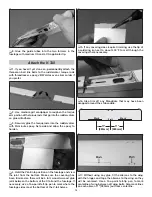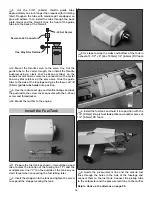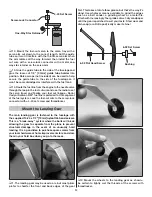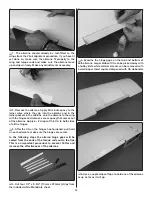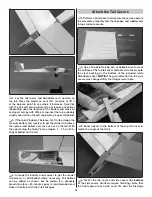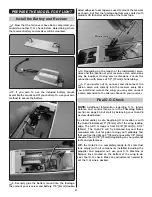
28
❏
4. Lay the tail covers and MonoKote (or a quarter) on
the tail. Place the model on your C.G. machine or lift it
at the balance point to see where it balances. Quik-V6s
with the 426 Jett setup will tend to not require any ballast
(depending upon the location of the battery and receiver)
and sport setups with different engines (that are probably
slightly heavier than the Jett engine) may require tail ballast.
❏
5. If the Quik-V6 doesn’t balance, fi rst try to arrange the
receiver battery and receiver to get the model to balance,
then place lead ballast over the nose or on the tail. With
the sport setup the Quik-V6 may require 1 – 1.5 oz. [30 –
40g] of ballast on the tail.
❏
5. Arrange the battery and receiver to get the model
to balance, or add ballast where necessary. Tail ballast
can be added as shown, but be certain it is
securely
glued into place—30-minute epoxy is recommended and
doesn't interfere with the V-tail linkages.
Attach the Tail Covers
❏
1. Perform a fi nal check to make sure the servos operate
the elevators smoothly and the linkages and ruddervator
torque rods are secure.
❏
2. Use a fi ne-point felt-tip pen or ballpoint pen to mark
the outlines of the top tail cover and both side covers onto
the clear backing on the bottom of the included white
MonoKote sheet.
NOTE:
The grain direction on the side
covers was changed after the images were taken.
❏
3. Sand a bevel to the bottom of the top tail cover to
match the angle of the V-tail.
❏
4. Test-fi t the top cover and side covers (the
bottom
of the side covers will likely require trimming). Note that
the front edge of each side cover fi ts
over
the fuselage

